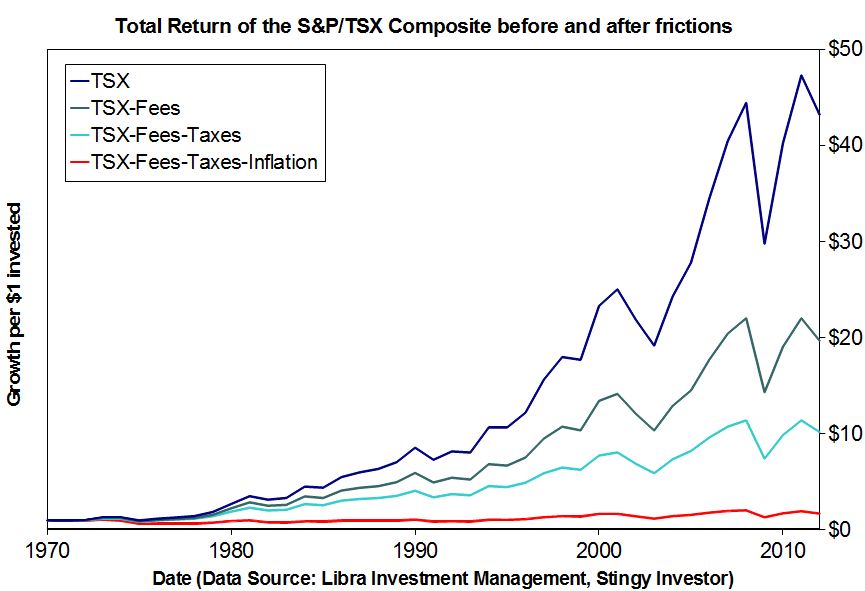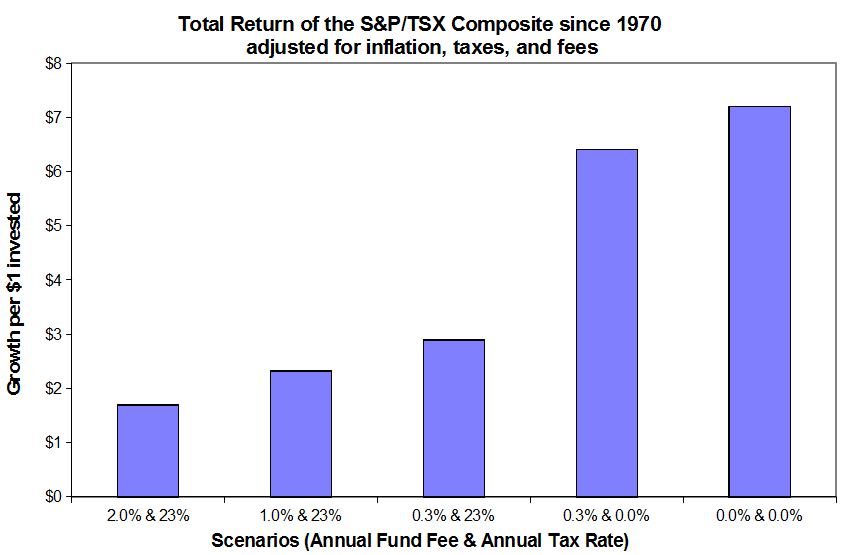3 villains can steal your retirement dreams
Building a strong financial castle to fund your retirement is hard. If
you're not careful, you may discover a hole in your vault and three
villains sneaking off with the family jewels.
To see these predators in action, let's begin by considering a
portfolio that follows the total return of the S&P/TSX Composite index
as shown in the following graph. The index has performed well since 1970 with
an average annual return of 9.4 per cent.

[larger version]
But these happy returns don't factor in the annual fees charged by
funds. These typically range between 2 per cent and 2.5 per cent for
Canadian stock funds and are called management expense ratios (MERs).
Problem is, funds - on average - have a hard time beating the index's
returns before fees. They tend to trail badly after fees. Indeed,
there are theoretical reasons to think that funds, as a group, merely
yield index returns less the fees they charge.
The fee line on the graph is based on the uncharitable view that funds
achieve index returns minus a 2 per cent annual fee. Over the period,
those seemingly small charges reduce the size of the ending portfolio
by more than 50 per cent. Such is the misery of compounded fees.
Fund fees are one thing but the crown also likes to extract a pound of
flesh. The third line on the graph - the one just under the fee line
- represents the returns of the index after the 2 per cent fund fee
and a 23 per cent tax on gains from the prior peak levied annually.
The point here isn't one of precision - after all, different investors
are subject to different tax burdens - but to highlight why proper tax
planning is important. Stingy investors want to legally reduce taxes
and fees, all else being equal.
Inflation is the third sapper of wealth and the last line on the graph
shows the combined impact of 2 per cent annual fees, 23 per cent
annual taxes on gains, and inflation.
The result? The 9.4 per cent starting annual return for the index is
reduced to a mere 1.3 per cent after fees, taxes, and inflation are
taken into account. Put in dollar terms, instead of growing each
dollar invested to $43.20 over the period, you'd only be left with
$1.70 after fees, taxes, and inflation.
But you can foil two of the villains. Fund fees can be reduced by
favouring low-fee active funds or lower-fee index funds and
exchange-traded funds. On the tax front, you can save via TFSAs or
defer taxes by using RRSPs or opting for longer holding periods.
The bar chart shows several different low-fee and low-tax
scenarios. For instance, a 0.3 per cent annual fund fee and a zero tax
rate would have put $6.40 in your pocket, adjusted for inflation, per
dollar invested. That's a darn sight better than $1.70.

[larger version]
The moral of the story? Be sure to keep a close eye on fees and
taxes. If you don't, a pack of villains might run off with the bulk of
your retirement portfolio.
First published in the Globe and Mail, January 28 2012.
|
|